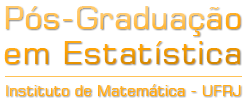Research Activities
In the last decades Statistics and Probability have evolved in a very fast way, either by the theoretical development or by the new technological advances and computational development. Some application areas posed several challenges for statistical and probabilistic methods, such as Image Processing, Biotechnology, Official Statistics, Pattern Recognition, Reliability, Forensic Statistics or Criminology, Particle Physics, Quantum Physics, Information Theory, Actuary and Economics. In the same period, complex probabilistic modeling and analysis as well as the Bayesian methods acquired a special status and penetrated practically all areas of knowledge including some where the applications of Statistics and Probability seemed remote.
In our program at UFRJ we develop research on contemporary themes in various branches of Statistics and Probability, including: Analysis of Spatio-temporal Data, Survival and Reliability Analysis, Spatial Statistics, Percolation, Limit Theorems for Particle Systems and Extreme Value Theory with applications in: actuarial, environmental sciences, epidemiology, hydrology, finance, mathematical physics. In Statistics, many of our researchers use the Bayesian methodology as a philosophy and also as a tool to solve problems in the most different areas. In Probability, we have a group that stands out in Stochastic Processes with applications in different fields.
Our main areas of research are listed below.



